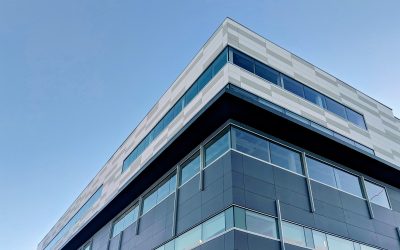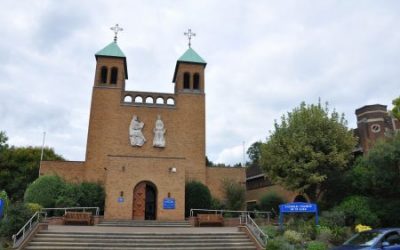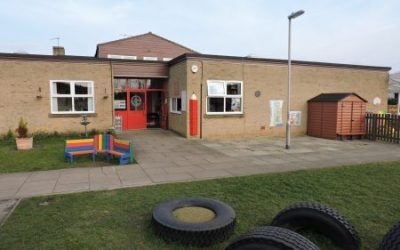St Michael and All Angels Church, Withington – The first zero carbon church in the UK.
St Michael and All Angels Church, Withington, Gloucestershire completed this project to become the first zero carbon church in the UK. It has achieved this in a Grade 1 listed late Norman Cotswold church through a combination of energy reduction and renewable energy generation from a biomass boiler and 24 solar PV panels on its south facing nave roof.
Understand the Demand and Reducing it.
The key starting point for the scheme was to gain a full understanding of the energy demand of the church and reducing this. The church is used for a Sunday service and one mid-week School service, as such the heating is required to be on for 7 hours per week. The main electrical energy use is for the lighting which is a mix of internal lighting (from 31nr spot lights) and external flood lighting.
The demand was reduced by altering the timing on the flood lights to go off at 10.30pm each night (reduced from midnight) and to be off completely from May to Sept. These times and dates were set following public consultation with the local village community and reduced the overall electrical demand by 13%.
The internal lights were then replaced from 120W PAR38 to 20W Compact Fluorescent Megaman PAR38 using a direct lamp replacement. This reduced the overall consumption by a further 24%.
Further plans are looking at the use of LED floodlights which will be installed when further funding is obtained. These will achieve a further 42% reduction in electricity.
The existing oil boiler was being fired every day in order to maintain reliability, a 45% energy reduction was possible by installing a more reliable boiler which did not require this ‘maintenance firing’.
Renewable Technologies
A combination of Solar PV for the electricity and a biomass boiler for the heat was selected as the most appropriate renewable combination to meet the buildings need.
Biomass was selected as there was an existing serviceable wet radiator system already within the church which suited a high temperature system. A ground source heat pump or the connection to an existing biomass plant at a farm estate complex on the other side of the road had to be discounted due to the archaeological issues of any excavation within the church yard. Due to the low weekly use of the boiler (7 hours per week) it was feasible to propose a manual loaded system for the wood pellets which would be supplied in 10kg bags. This removed the need for a large hopper in which to store the pellets. The manual load hoppers store 250 kgs and at the use of 60kgs per week this requires filling every 4 weeks.
The removal of the oil tank from the church yard was seen as an additional benefit by providing more space and removing both pollution and a security risk from theft of oil.
As with most churches this building has an east/west orientation of the aisle which, as the nave has a pitched roof, one side of the pitch faces due south. The roof is at 30 degrees and entirely hidden by a parapet around all sides. The installation of PV would therefore be ‘invisible’ which was then acceptable for this listed building. The size of the array was selected as a balance between more than meeting the estimated annual electrical demand of the building and filling the optimal roof space available. A 3.24kWp system of 24 panels covering 24.05m2 was chosen.
Challenges and Innovation
The key issue with the solar panels was one of fixing them to the existing roof. No penetrations were permissible through the copper clad roof and therefore a self weighted system on a pitched roof had to be adopted. While self weighted systems for flat roofs are available a more innovative approach based on a ‘roof ladder’ principle had to be adopted. An innovative, yet simple structural framework was designed by Sinclair Johnston and Partners to provide a very effective solution which involved extensive investigation into the structural capacity of the existing roof.
Additionally careful consideration had to be given to the cable route from the panels to the meter. The cables now use the route of the rainwater goods.
With the biomass installation the significant challenge was getting the sizable and heavy boiler down the narrow stairs into the existing plant room. A Froling P4 pellet boiler was selected as this could be largely dismantled to allow for improved access.
Costs and Figures
The biomass installation is a 38kW Froling P4 biomass pellet boiler which replaces an old oil boiler. Previous oil usage was 4,000l/year at a cost of around £1,500, carbon emissions were 12,116kgCO2e/year. The use of biomass pellets is estimated to be around 2 tonnes at a cost of £400/year. Carbon emissions from these are estimated to be 0.052kgCO2e/year. The biomass installation will therefore save £1,100 per year in fuel costs and over 12 tonnes in carbon emissions. The cost of the installation was £23,110.
The PV installation is a 3.24kWp array of 24 Kyocera modules which will have an estimated annual generation of 2,592kW. The total cost (including specialist structure design) was £18,057. The system will gain Feed in (Generation) Tariff of £1,070 per year and an estimated export of 80% providing a further £62/year, a further £60 will be saved by avoided purchase.
The unimproved electrical consumption was 2,930kWh/year, costing £338 and emitting 1,594 kgCO2e/year. Following efficiency measures this has been reduced to 1,838 kWh/year. The efficiency measures cost £510 to complete providing an annual saving of £125/year and 595kgCO2e/year.
The church will have an overall net export of electricity of 754kW/year providing a positive carbon abatement of 410kgCO2e/year and more than meeting its zero carbon status.
Key Facts:
Grade 1 Listed Building – Now Fully Zero Carbon
Renewable Technology Installed:
3.24kWp Solar PV Array
38kW Biomass Pellet Boiler
Total Cost of £43,500 Funded from:
Gloucestershire Environmental Trust – £5,000
Community Sustainable Energy Programme – £11,555
Low Carbon Buildings Programme 2e – £11,555
Church Own Funds – £5,000
Any other generous private donations
Innovation: Self Weighted ‘no fix’ solar panel framework on a pitched roof to preserve historic fabric
Installer: Dulas Ltd
Consultants: Inspired Efficiency / Sinclair Johnston and Partners (Structural)
Latest Case Studies.
Net Zero Carbon Project for St Andrews CofE Primary School
St Andrews CofE Primary School.22 JUN 2016[DISPLAY_ULTIMATE_PLUS]Net Zero Carbon ProjectSt Andrews CofE Primary School, Chedworth was successful in obtaining a £120,000 grant through the government’s Public Sector Decarbonisation Scheme to transition to a Net Zero...
Funding for Energy Audits / Decarbonisation Advice
The recent announcement of the use of the £1bn funding to improve the energy efficiency of the public sector buildings has set a funding landscape for energy saving projects that has not been seen in the last 10 years…
Delivery of energy efficiency measures
Delivery of energy efficiency measures.07 JUL 2016[DISPLAY_ULTIMATE_PLUS]IE installed energy measures Endotherm, SavaWatt and LED lighting following ESOS advice.Introduction Follow IE’s advice on energy saving that could be implemented on this site through the Diocese...
Controls optimisation for LA schools
Controls optimisation for LA schools.07 JUL 2016[DISPLAY_ULTIMATE_PLUS]IE conducted controls optimisation for schools where initial energy management contact by LA has identified that controls are problematic.IntroductionThis Local Authority has its own in house...


